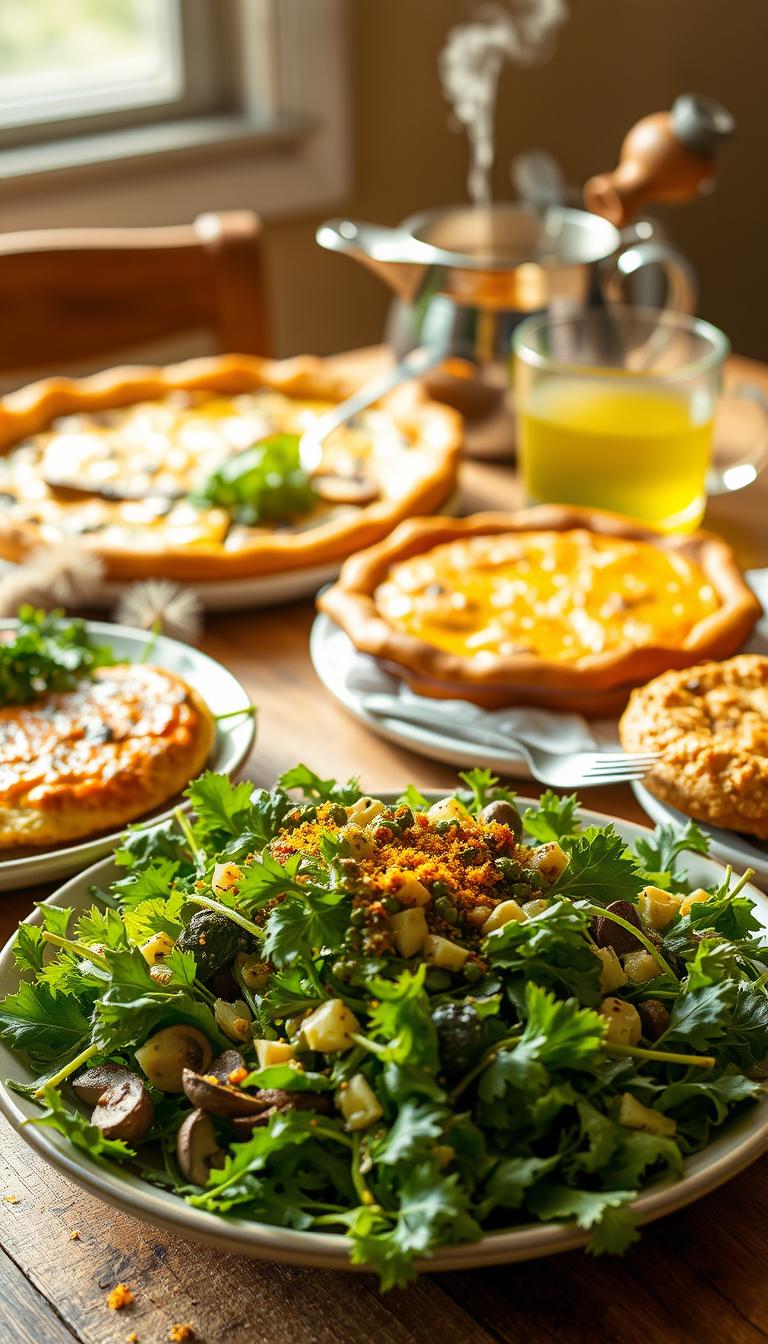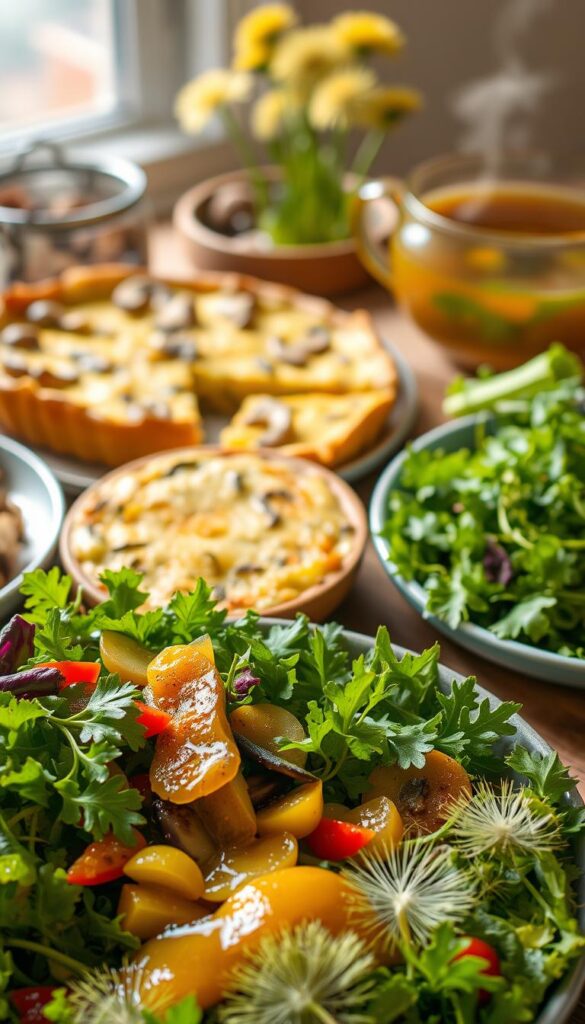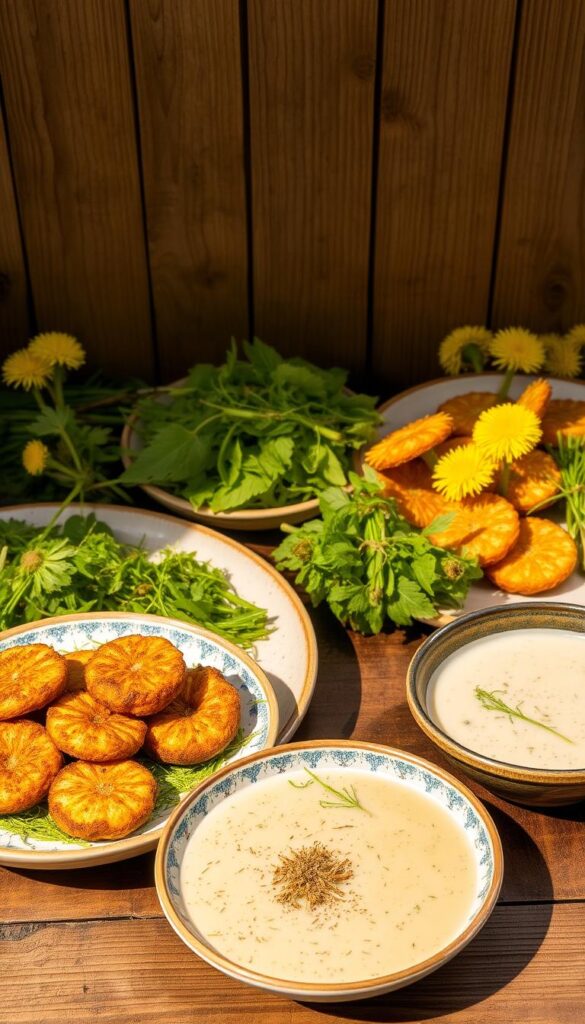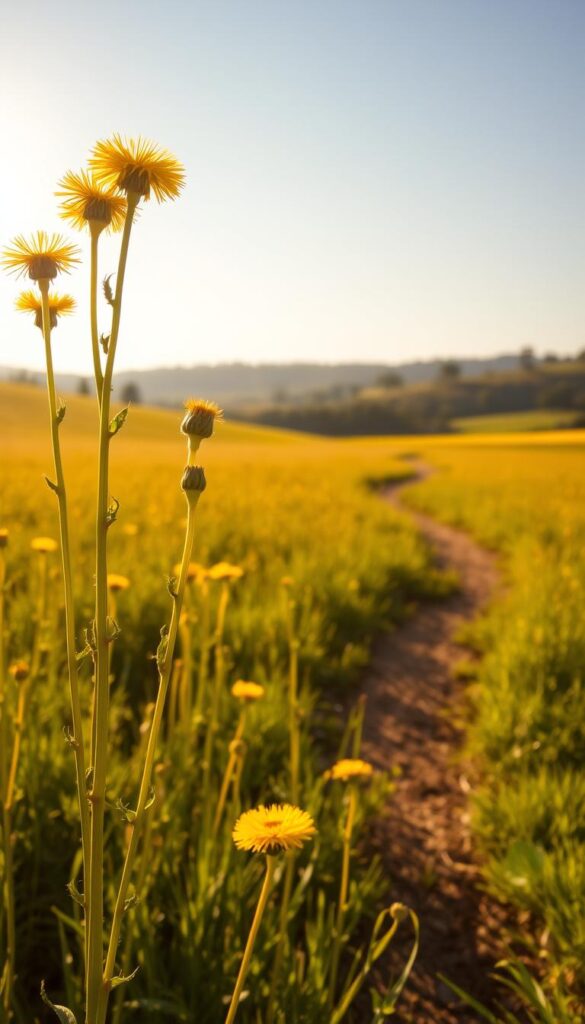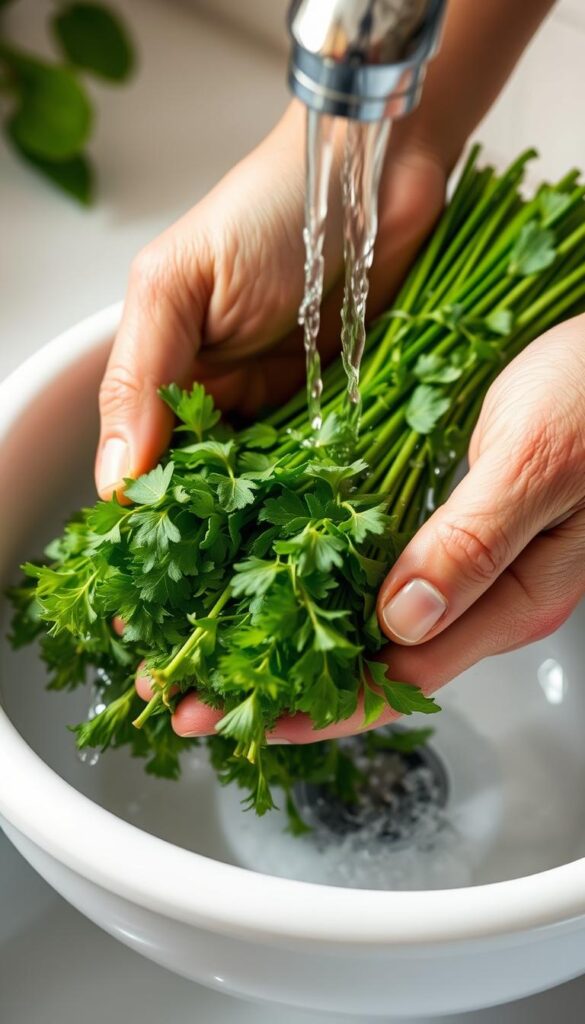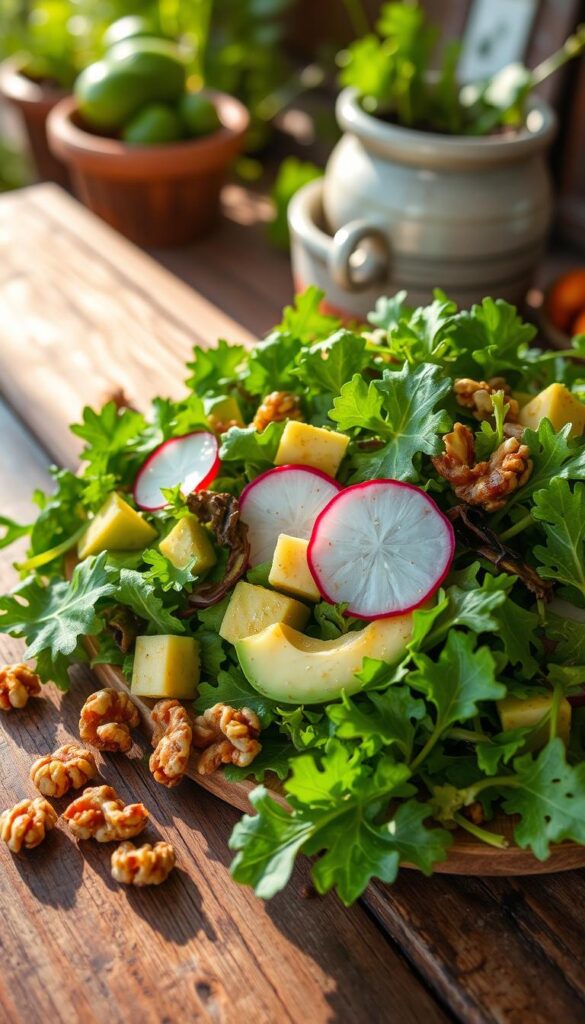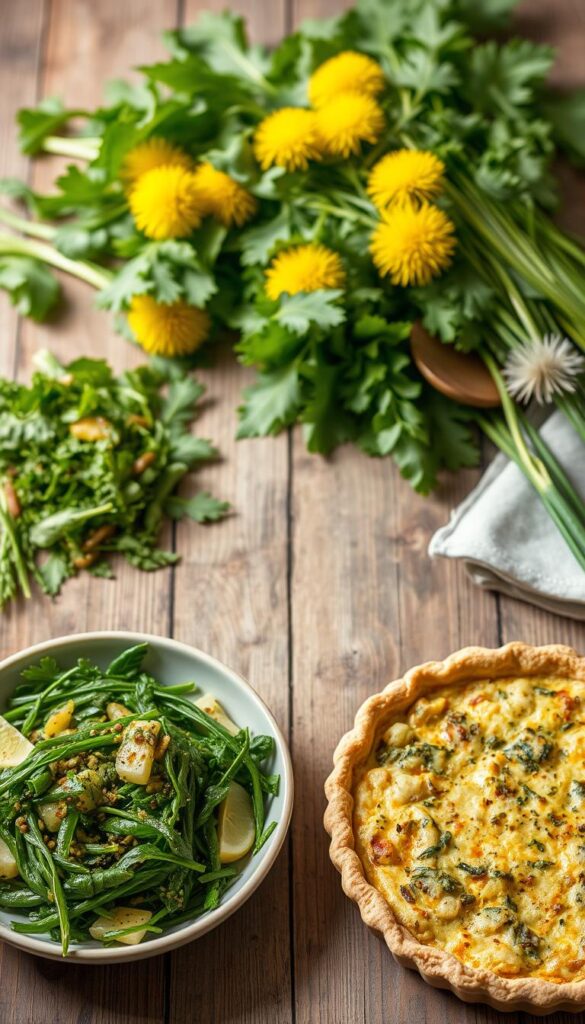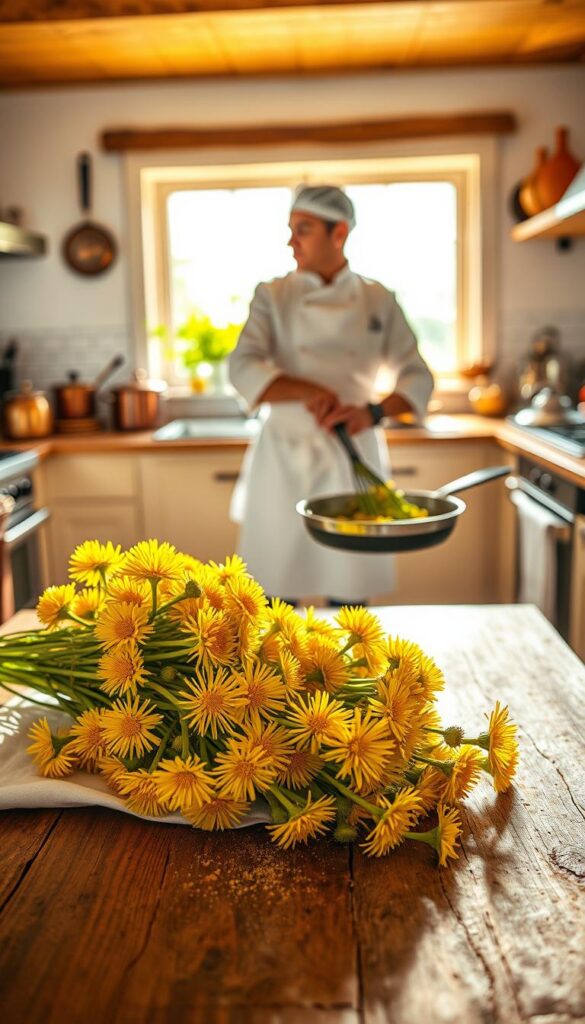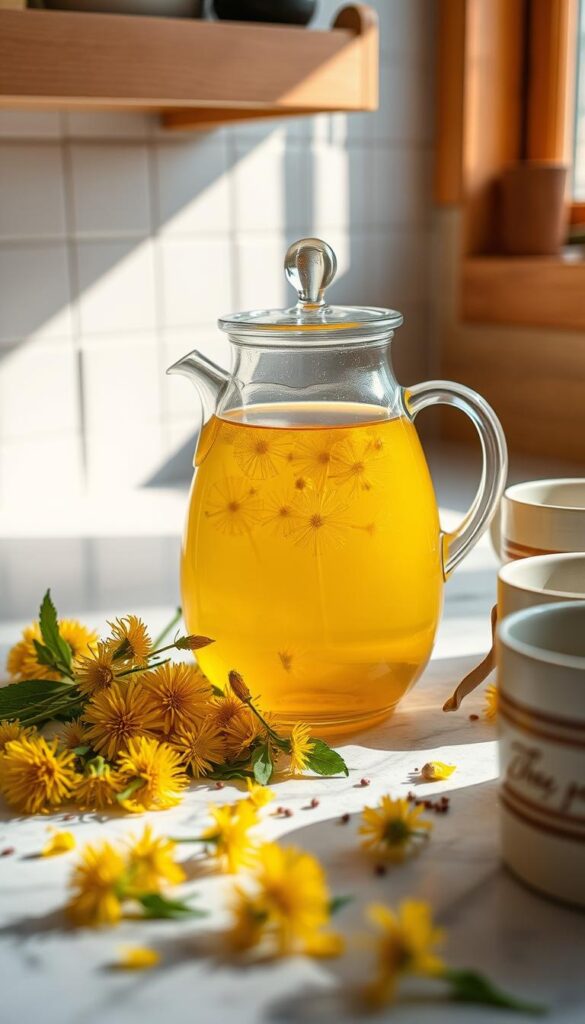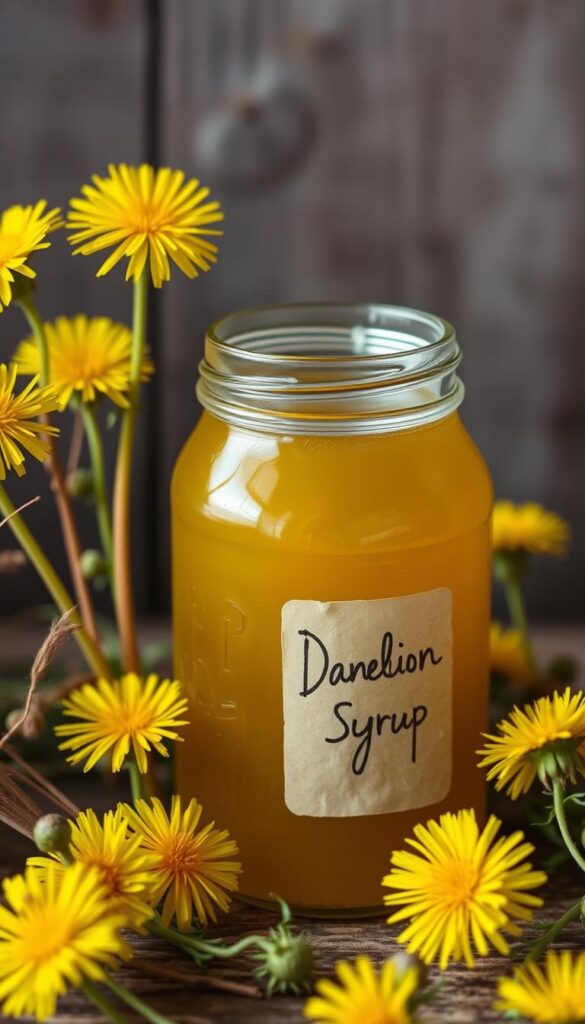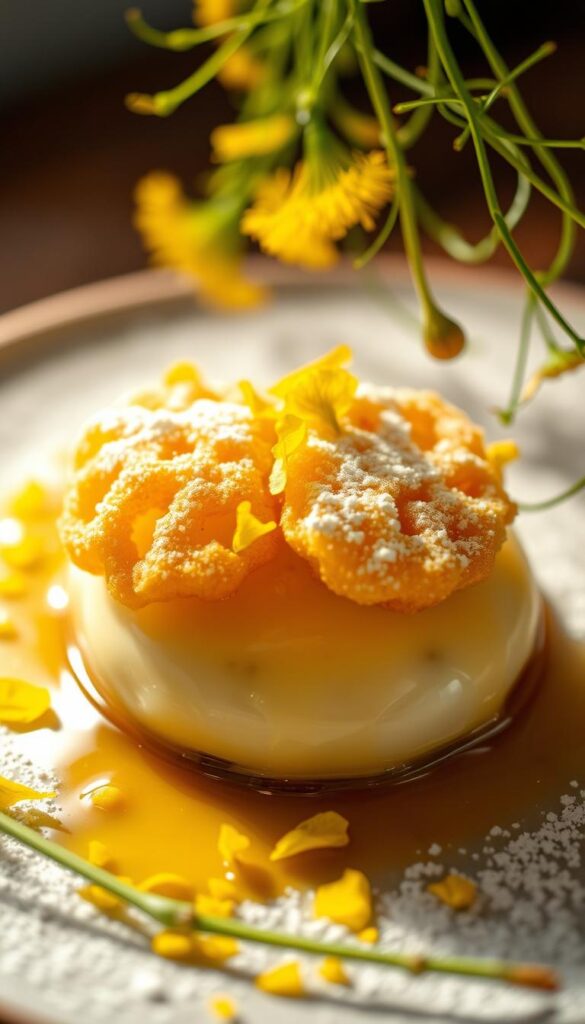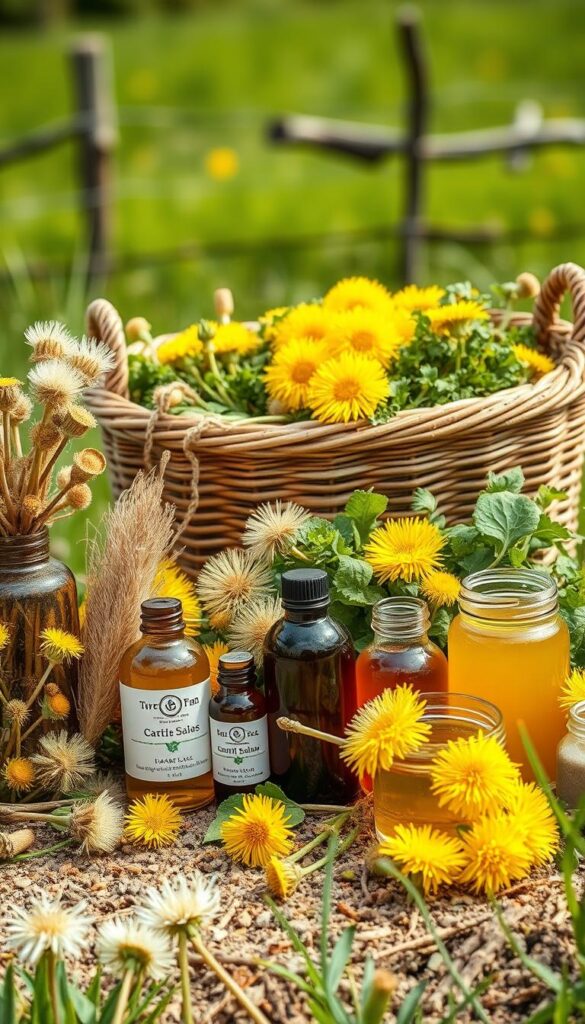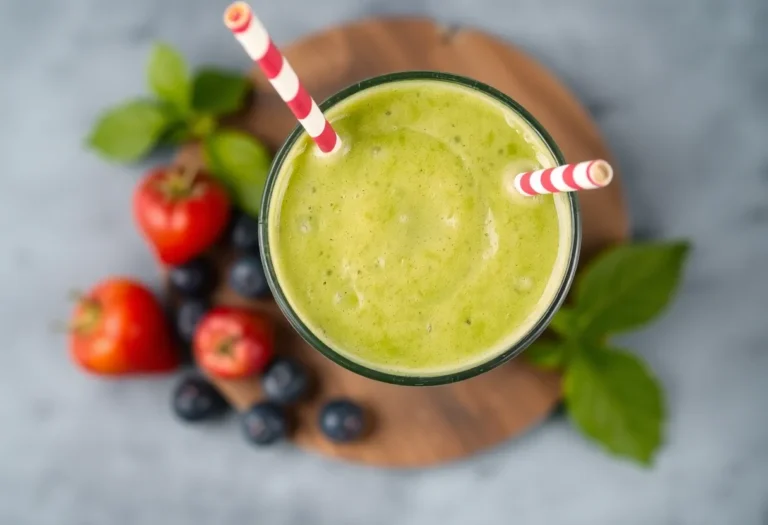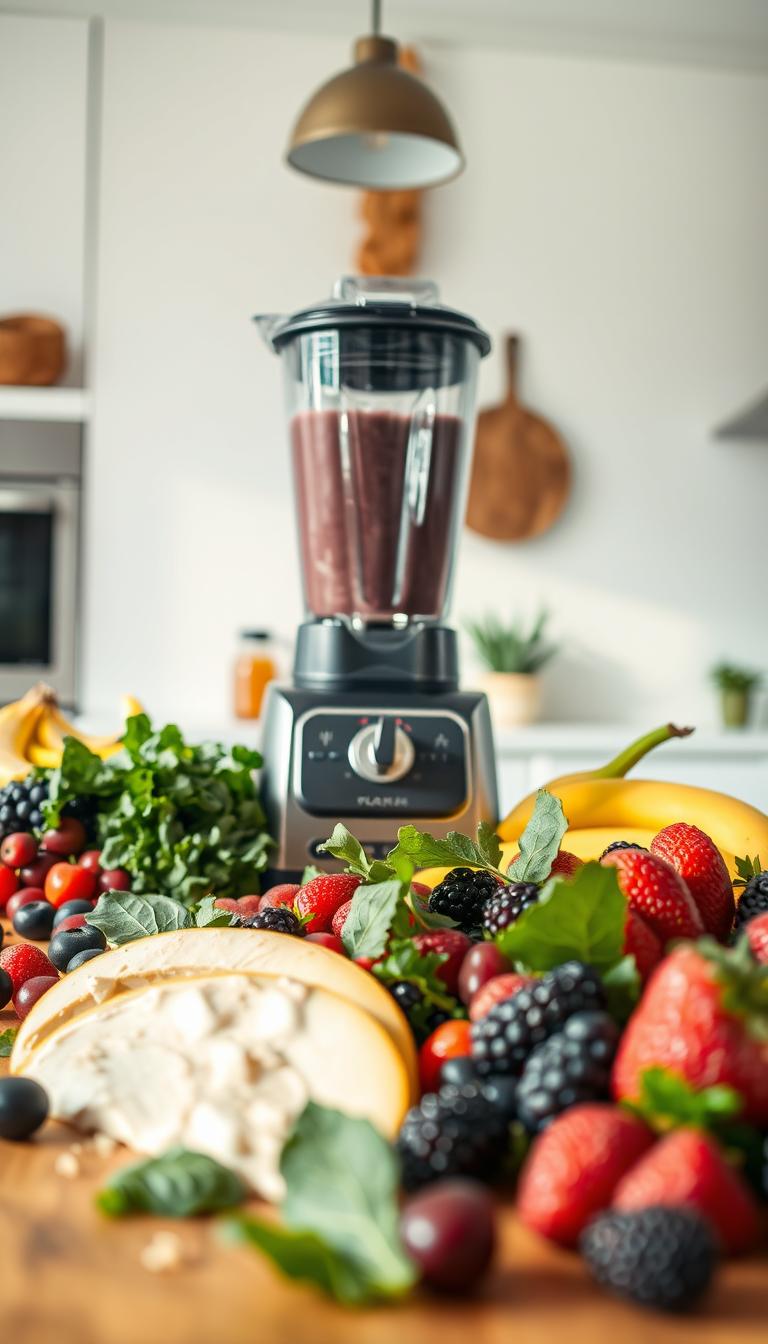10 Dandelion Recipes: Enjoy the Taste of Nature
Have you ever thought about turning the weeds from your garden into tasty meals? Dandelions, often viewed as pests, hold a wealth of culinary possibilities. This article delves into various dandelion recipes, turning these vibrant plants into delicious dishes. They highlight the plants’ nutritional value and versatility. Whether you’re an experienced forager or new to cooking with dandelions, you’ll discover dishes that enhance your dining experience.
Let’s embark on a journey through foraging recipes with dandelions, focusing on their remarkable health benefits and clean eating. It’s time to change how we see this common plant and learn to include it in our meals!
Introduction to Dandelions as Edible Plants
Dandelions, once seen as mere weeds, hold a wealth of culinary and medicinal value. Introduced to North America by European settlers, they were prized for their nutritional benefits. Now, their culinary uses are gaining attention, as people explore ways to incorporate them into tasty dishes.
These plants thrive in many environments, from backyards to open fields. Foraging for dandelions allows us to engage with nature and access fresh, free ingredients. Their leaves, flowers, and roots are versatile, used in everything from salads to drinks, highlighting their importance in today’s cooking.
Health Benefits of Cooking with Dandelions
Dandelions are often seen as weeds, but they are packed with health benefits. They are rich in vitamins and minerals, making them a great addition to any diet. Adding dandelions to your meals can boost flavor and promote a healthier lifestyle.
Nutritional Value of Dandelions
Dandelions are packed with nutrients, including vitamins A, C, K, and folate. They also contain essential minerals like calcium and potassium. One cup of raw dandelion greens can offer impressive health benefits. Here’s a quick look at their nutritional content:
| Nutrient | Amount per 1 Cup (Raw) |
|---|---|
| Calories | 25 |
| Vitamin A | 112% of Daily Value (DV) |
| Vitamin C | 32% of DV |
| Vitamin K | 535% of DV |
| Calcium | 10% of DV |
| Potassium | 6% of DV |
How Dandelions Contribute to Healthy Eating
Adding dandelions to your meals can greatly improve your diet. Their anti-inflammatory properties offer antioxidant support, vital for overall health. Cooking with dandelions aids digestion and brings numerous health benefits to your meals. They can be used in salads, soups, or smoothies, making it easy to add nutritious ingredients to your daily diet.
Dandelion Recipes: Transforming Weeds into Delicacies
Dandelions are often seen as pesky weeds, but they hold incredible culinary value. With the right approach, you can explore a variety of the best dandelion recipes. Each part of the dandelion is edible, making it an outstanding ingredient for innovative dishes.
One popular way to utilize dandelions is in salads. Combining fresh dandelion greens with fruits, nuts, and a zesty dressing creates a delightful dish bursting with flavor. Other culinary uses for dandelions include incorporating them into hearty soups and savory frittatas, allowing you to savor their earthy taste.
For dessert lovers, dandelion flowers can be transformed into creative sweets. Experimenting with good quality honey and flour, you can whip up scrumptious dandelion blossom cookies or even unique dandelion cupcakes. In these ways, delicious dandelion meal ideas can easily elevate your cooking game.
Here is a small selection of ways to integrate dandelions into your meals:
- Fresh Dandelion Greens Salad
- Dandelion Root Tea
- Fried Dandelion Flowers
- Dandelion Pesto
- Dandelion Blossom Syrup
With their numerous culinary uses, dandelions can transform from simple weeds into gourmet ingredients. Enjoy discovering the versatility of dandelions in your kitchen!
How to Forage Dandelions Safely
Foraging for dandelions is a rewarding activity for those who love nature and food. It’s important to know how to identify edible plants to safely gather these nutritious weeds. Be cautious, as herbicides may be used in urban areas or near roads. Here are some guidelines for a safe and sustainable foraging experience.
Identifying Edible Dandelion Varieties
It’s vital to identify edible dandelion varieties to avoid hazards. The common dandelion, Taraxacum officinale, is the most foraged type. It has jagged leaves, bright yellow flowers, and a hollow stem. This variety is both tasty and nutritious. Other varieties, like red or purple dandelions, may also be safe but need careful examination to confirm their safety. Key identification features include:
- Bright yellow flowers that open in the sun and close at night.
- Deeply lobed leaves, often showing a rosette formation at the base.
- Hollow stems that can be easily snapped.
Best Practices for Foraging
Safe foraging practices are essential. Follow these tips for a responsible foraging experience:
- Choose clean, chemical-free locations for foraging dandelions. Avoid areas near busy roads or those treated with pesticides.
- Harvest only what you need, leaving enough for the ecosystem and local wildlife.
- Forage during spring, when dandelions are young and tender, ensuring freshness and optimal flavor.
- Use gloves when handling any plants to protect against possible irritants or pathogens.
- Educate yourself on local edible plants and possible look-alikes that may be toxic.
Practicing safe foraging not only enhances your culinary experience but also respects the environment. Dandelions are abundant, so enjoy the foraging journey while prioritizing your safety and the sustainability of nature.
Preparation Techniques for Dandelions
Mastering the art of preparing dandelions is key to enjoying their full flavor. Whether you’re interested in cleaning dandelion greens or exploring cooking methods for roots and flowers, these tips will guide you to delicious results.
How to Clean Dandelion Greens
Cleaning dandelion greens properly is vital to remove dirt and grit. Follow these steps for clean greens:
- Start by selecting fresh dandelion greens, ensuring they are tender and young.
- Fill a large bowl with cold water.
- Submerge the greens in the water, gently swirling them to loosen dirt.
- Inspect the leaves for any damaged areas and trim them away.
- Remove the greens and place them in a colander.
- Rinse under cool running water to remove any remaining contaminants.
- Drain well and pat dry with a clean kitchen towel or use a salad spinner.
Cooking Methods for Dandelion Roots and Flowers
Different cooking methods can greatly enhance the flavor and texture of dandelions. Here are some effective techniques you can try:
- Steaming: Preserve the nutrients while making the greens tender.
- Sautéing: Quickly cook the greens with olive oil and garlic for a flavorful side dish.
- Roasting: Roast the dandelion flowers to bring out their natural sweetness, perfect for adding to salads.
Delicious Dandelion Salad Recipes
Dandelion greens bring a unique taste to salads, making them more than just a meal. Using fresh, foraged greens creates dishes that are both nourishing and delicious. Here are some tasty dandelion salad recipes to try at home. Each dish offers a distinct flavor, making them great for those seeking healthy salad options.
Classic Dandelion Green Salad
This salad highlights the natural bitterness of dandelion greens. It’s balanced by olive oil’s richness and vinegar’s tang. It’s a perfect way to start exploring dandelion greens in cooking.
- 2 cups fresh dandelion greens
- 1/2 cup sliced cucumber
- 1/4 cup cherry tomatoes, halved
- 1/4 cup red onion, thinly sliced
Dressing:
- 3 tablespoons olive oil
- 1 tablespoon balsamic vinegar
- Salt and pepper to taste
Combine all salad ingredients in a bowl. Whisk the dressing ingredients together. Drizzle over the salad and toss gently.
Dandelion Greens with Citrus Vinaigrette
This salad boosts dandelion greens with a zesty citrus dressing. It’s ideal for those who want a healthy salad that’s also exciting.
- 2 cups dandelion greens, chopped
- 1 orange, segmented
- 1/2 grapefruit, segmented
- 1/4 cup sliced almonds
Citrus Vinaigrette:
- 1/4 cup orange juice
- 2 tablespoons olive oil
- 1 teaspoon honey (optional)
- Salt and pepper to taste
Whisk the vinaigrette ingredients together. Mix with the salad components. Serve immediately for a burst of flavor and nutrition.
Cooking with Dandelion Greens: Easy Recipe Ideas
Dandelion greens are not just nutritious; they’re also incredibly versatile in the kitchen. They offer a wealth of easy recipe ideas that highlight their unique flavor and health benefits. This makes them perfect for anyone looking to cook healthy meals. A great example is the dandelion greens frittata, which is great for any meal of the day. It showcases the greens’ distinct taste while providing a nutritious option for any time.
Dandelion Greens Frittata
Making a dandelion greens frittata is straightforward and requires just a few ingredients. Here’s how to make this tasty dish:
- Ingredients needed:
- 2 cups fresh dandelion greens, chopped
- 6 eggs
- 1/2 cup milk
- 1 cup cheese (optional)
- Salt and pepper to taste
- Olive oil or butter for cooking
Health Benefits of Dandelion Green Dishes
Eating dishes with dandelion greens regularly can boost your health. These greens are packed with vitamins A, C, and K, along with minerals like calcium and iron. Adding them to your meals can increase dietary variety and promote healthy eating. Their natural bitterness can also enhance the flavors of other dishes, making them a nutritious addition to any meal.
| Nutrient | Amount per 100g |
|---|---|
| Calories | 45 |
| Protein | 2.7g |
| Fat | 0.7g |
| Carbohydrates | 9.2g |
| Fiber | 3.5g |
Exploring Dandelion Flower Recipes
Dandelion flowers add a vibrant touch to your garden and can be turned into tasty dishes. Cooking with dandelion flowers unlocks a realm of culinary innovation. You can enjoy everything from crispy fried flowers to sweet cookies, all made with dandelion flowers.
Fried Dandelion Flowers Recipe
This recipe showcases the crunchy texture and sweet taste of dandelion flowers, perfect as a snack or garnish. To start, you’ll need:
- 1 cup fresh dandelion flowers
- 1 cup of flour
- 1 cup of water
- Salt and pepper to taste
- Oil for frying
First, rinse the flowers to get rid of any dirt. Then, mix flour, water, salt, and pepper in a bowl to make a batter. Coat the dandelion flowers in the batter and fry them in hot oil until they’re golden. Serve them warm for a tasty treat.
Dandelion Blossom Cookies
These cookies offer a unique taste, capturing the sweetness of dandelion blossoms. To make these treats, you’ll need:
- 1 cup dandelion blossoms, cleaned and free of green parts
- 1 cup sugar
- 1/2 cup butter, softened
- 1 egg
- 2 cups all-purpose flour
- 1 tsp baking powder
- 1 tsp vanilla extract
Start by creaming sugar and butter together. Add the egg and vanilla, then mix well. Gradually add flour and baking powder, making sure to blend well. Lastly, add the dandelion blossoms. Scoop spoonfuls onto a baking sheet and bake at 350°F for 12-15 minutes. These cookies beautifully highlight the flavor of dandelion flowers.
Crafting Unique Dandelion Beverages
Delving into the realm of dandelion beverages reveals a world of refreshment for those who cherish foraged ingredients. The process of making dandelion tea and crafting a dandelion wine recipe stand out. They present distinct flavors, highlighting the plant’s versatility.
How to Make Dandelion Tea
Creating dandelion tea is straightforward, focusing on its detoxifying benefits. Begin by collecting fresh dandelion greens, flowers, and roots. Rinse them well to eliminate dirt. Then, chop the greens and roots, ready to be used in a teapot.
Subsequently, pour boiling water over the dandelion parts and let it steep for about 10 minutes. Strain the liquid to discard the solids. You can add honey or lemon for sweetness or zest. This herbal infusion is both calming and invigorating, suitable as a warm or iced drink.
Refreshing Dandelion Wine Recipe
The dandelion wine recipe is a treasured tradition that celebrates the vibrant flowers in a fermented drink. Start by selecting about 2 cups of dandelion blossoms, ensuring they are pesticide-free. Place the flowers in a large pot, adding 1 gallon of water and the juice of 2 lemons.
Boil the mixture, simmering for about 30 minutes. Strain the liquid, discarding the flower petals. Add sugar to taste and a bit of yeast to start fermentation. Let the mixture ferment for about three weeks. Once fermented, bottle the wine and age it for at least a few months for enhanced flavor.
Creating Dandelion Syrups and Jellies
Turning dandelions into sweet condiments opens a world of culinary creativity. Dandelion syrup brings a unique twist to traditional sweeteners. Dandelion jelly recipes capture the floral essence of these vibrant flowers. Preserving dandelions allows enthusiasts to enjoy their delightful flavors all year.
Dandelion Blossom Syrup Recipe
To make a flavorful dandelion syrup, gather fresh dandelion blossoms, ensuring they are free from pesticides. Combine the fresh flowers with water, a bit of lemon juice, and sugar. Then, simmer until the mixture thickens. Strain the flowers and bottle the syrup for a delightful addition to pancakes, teas, or desserts.
How to Make Dandelion Jelly
Making dandelion jelly is an enjoyable way to experience the sweetness of the season. Start by brewing dandelion petals in water to create an infused liquid. Mix this infusion with pectin and sugar, and allow it to boil. The result is a homemade jelly that spreads beautifully on toast or pairs well with various cheeses.
Innovative Dandelion Dessert Ideas
Exploring dandelion desserts requires creativity. Using dandelions in sweets leads to unique and innovative ideas. Here are two exciting recipes to transform your baking.
Dandelion Baklava Recipe
Dandelion baklava offers a twist on the traditional Mediterranean dessert. Dandelion petals add an earthy flavor that complements the sweet, nutty filling. To make this dessert, you’ll need:
- Layered phyllo dough
- Chopped nuts (walnuts or pistachios)
- Dandelion petals, cleaned
- Butter, melted
- Honey
- Spices (cinnamon, nutmeg)
This foraged dessert combines aromatic phyllo layers with a honeyed syrup. The result is a decadently crunchy exterior with a succulent filling.
Dandelion Cupcakes with Honey Frosting
Dandelion cupcakes with honey frosting are a whimsical treat. They taste fantastic and add colorful dandelion flowers to your dessert table. Ingredients include:
- All-purpose flour
- Sugar
- Eggs
- Milk
- Dandelion petals
- Butter
- Honey for frosting
The floral notes from the dandelions enhance these light and fluffy cupcakes. Sweet honey in the frosting complements the earthiness, making this dessert innovative.
Using Dandelion Products Beyond Cooking
Dandelions are more than just a culinary delight; they boast a range of non-culinary applications. Many dandelion products include dandelion-infused oils, teas, and herbal salves, which serve various purposes. These products harness the plant’s natural properties, providing benefits that extend beyond the kitchen.
In herbal remedies, dandelion uses are diverse and widely recognized. The leaves and roots of the dandelion plant possess antioxidant qualities and may aid in digestion. Notably, dandelion extracts are often employed in natural skincare regimens, helping to soothe and nourish the skin.
The versatility of dandelions empowers individuals to explore their extensive versatility. From crafting homemade herbal remedies to enriching natural beauty routines, dandelion products contribute meaningfully to holistic wellness practices. Engaging with this resilient plant encourages a deeper appreciation for nature’s offerings.
Conclusion
The journey into dandelion recipes reveals the incredible versatility and nutritional value of this plant. It’s not just about foraging and cooking; it’s about enriching our meals and promoting a waste-free kitchen. By using dandelion greens, flowers, and roots, we celebrate foraged foods and the natural world.
Dandelions become a key player in sustainable cooking, helping us reduce our environmental impact. They transform what many see as weeds into tasty, nutritious dishes. This way, home cooks can enjoy nature’s flavors while supporting eco-friendly habits.
The growing interest in home cooking and foraging makes dandelion recipes even more appealing. They offer a creative way to enhance our meals, leading to a more sustainable food future. Here, deliciousness and environmental awareness are perfectly aligned.

